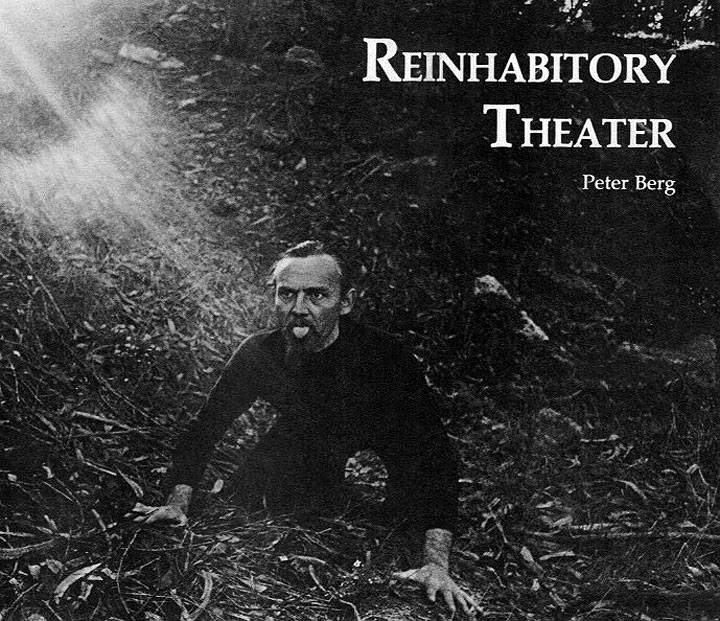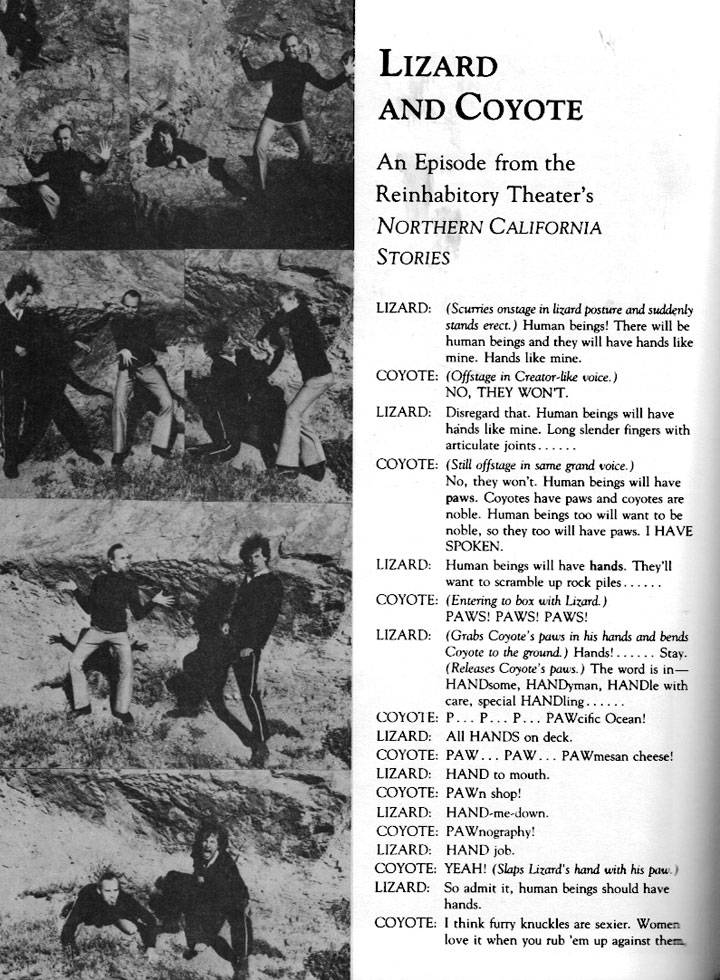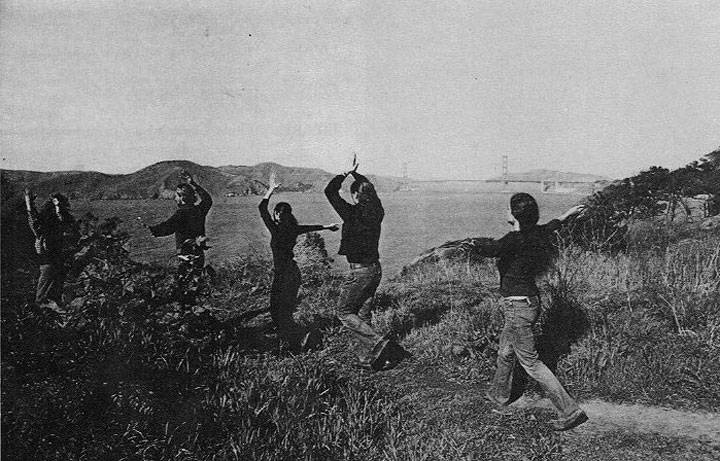Reinhabitory Theater: A Legacy of Inspiring Bioregionalism Through Storytelling
Historical Essay
by Yeshe Salz
Photo: Eric Weber, Source: Reinhabiting a Separate Country, 1978
In the San Francisco Bay Area during the 1970s, the ecology movement was gaining momentum. Earth Day was born, the back-to-the-land movement was coming into full swing, and myriads of new environmentally focused community organizations were sprouting up. One of them was Planet Drum, an organization that set out to build grassroots awareness and community self-determination around ecology.[1] The founders of Planet Drum emerged from the lively Bay Area improvisational, political and community theater scene of the day when groups such as the San Francisco Mime Troupe and the Diggers were capturing the imagination of people across the country, even internationally.[2] In 1977 a handful of these artists/ environmentalists, spearheaded by Judy Goldhaft and Peter Berg, set out to dynamically integrate the worlds of popular education theater and environmentalism. They traveled through the coasts and inland ranges of northern California performing improvisational renditions of traditional Native American stories from the regions which they visited. They were the stories of animals and places, inspired by the oral traditions of the native Northern California Pomo, Maidu, Karok and Pit River tribes which have been collected in books such as ethnomusicologist Jaime de Angulo’s Indians in Overalls.[3] The group called their multi-species performance troupe the Reinhabitory Theater.
An “early experiment in ecological theater,”[4] the Reinhabitory Theater sought to engage the local communities they visited in the experience of living from a bioregional perspective. Their performances invoked the interdependence of all species, including human beings. “Audiences will have to be shown reasons to suspend whatever preconceptions they may have about a central place for humans in the biosphere,” wrote Peter Berg in an articulation of the vision of Reinhabitory Theater.[5]
The actors in Reinhabitory Theater, often coming from experiences in the SF Mime Troupe or Minneapolis’ Firehouse Theater, founded and shaped the performances as a way to extrapolate upon bioregional ideas through improvisation, performance and community-based workshops. The Reinhabitory Theater actors creatively merged the worlds of environmentalism and theater, using performance and storytelling to address and explore the foundational bioregional concepts introduced by Planet Drum.[6]
Judy Goldhaft, who got her start in performance as a dancer, began doing mime workshops on animal behavior in 1975 and eventually incorporated this work, as well as her training in movement theater at SF Mime Troupe, into her guidance of the Reinhabitory Theater. [7] In Peter Coyote’s reflection on his involvement with Reinhabitory Theater, he writes how “...coached by Judy’s quiet encouragement and insistence and Peter’s mad-cap and insightful illuminations… we assembled ‘a show.’ It was something of a miracle. We had discovered a way to discuss two new concepts—bioregionalism and reinhabitation—in the same wacky manner we had once conscripted to discuss political issues in the San Francisco Mime Troupe.” [8]
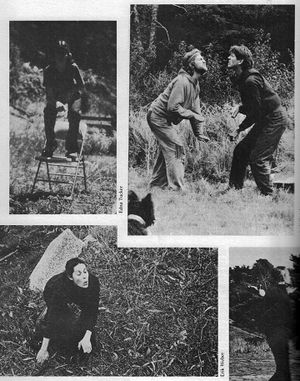
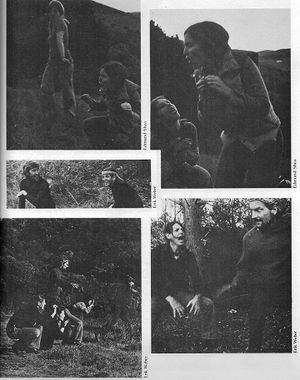
Photos: (from left to right, top to bottom) Edna Tucker, Erik Weber, Judi Quick, Edmund Shea, Erik Weber, Erik Weber, Edmund Shea, Erik Weber; Source: Reinhabiting a Separate Country, 1978
The idea of “bioregions” was at the center of the project. According to Peter Berg, “bioregions” are locations that share climate, watersheds, landforms, soils, native plants, animals and other natural characteristics. Berg writes that, “The term refers both to geographical terrain and a terrain of consciousness—to a place and the ideas that have developed about how to live in that place.“ [9] Furthermore, “reinhabitation”, a term he coined, is the act of becoming native to places in order to adapt to the bioregion.[10] As Coyote puts it, “reinhabitation” is the process of “learning how to live in a place according to the dictates of the place itself.” [11] It is a concept developed within a broader “bioregionalist” framework of thinking.
Bioregion was a 19th century biology term that was redefined by Raymond Dasmann and popularized by Berg [12] as well as others such as Gary Snyder in his article, “Coming into the Watershed.” [13] Bioregionalism refers to the philosophy of living as a human in a way that is appropriate to one's own bioregion. Berg said that, “Bioregionalism is proactive. It is carrying the concept of a life-place into the activities and goals of human society… In a bioregion there are different zones of human interface with natural systems: urban, suburban, rural, and wilderness. And each of these has a different appropriate reinhabitory approach.” [14] According to Berg, the purpose of the Reinhabitory Theater was to inspire this kind of consciousness. [15]
Because Reinhabitory Theater was about reimagining our relation to the natural world, they performed in a variety of locations. “We did the Reinhabitory Theater in a lot of places,” recalled Judy Goldhaft. “We did it outside, and we did it inside. We did it… underneath the freeway. We did it at grange halls, we did it in cow pastures, we did it in living rooms.” [16] The structure of the performance, including those who watched it, constantly changed as well. “Our audiences were all kinds of people,” Goldhaft reflected, “and when we did this theater we didn’t do it just as a theater. We did workshops, community empowerment workshops, at the same time.” [17] These workshops engaged participants in movement and improvisational storytelling. Often the skills learned in these workshops were used to re-enact scenes of injustice on stages and in courtrooms to make political statements and fight for environmental protection. [18]
Photos: Shafi Hakim; Source: Reinhabiting a Separate Country, 1978
The Reinhabitory Theater was also a direct response to the back-to-the-land movement of the 60s and 70s in which people from the cities chose to move to rural settings to be homesteaders. Goldhaft states, “They got very little support, and this theater was designed to let them know that what they were doing was important.”[19] The Reinhabitory Theater celebrated ways of living that prioritized being in touch with the earth’s natural rhythms and ecosystems and created a space to connect communities engaging in this kind of lifestyle. Judy reflected that, “It’s really my hope that we’ll turn people on to investigate where they live and the stories that have gone down in the place where they live…We see theater as helping to create a network among the communities.” [20] Such network-building and place-based thinking was all a part of the ways in which the artists and environmentalists in the Reinhabitory Theater were reimagining possible ways of living. “The seventies were really quite a revolutionary time,” Judy said in her interview for this article, “and the Reinhabitory Theater was a way to present a different reality to make a different society.” [21]
The Reinhabitory Theater did not last into the 1980s, but its legacy did. “We ended it in about ’79 or ’80,” states Goldhalf. [22] As Peter Coyote jovially remembers, “‘Everything Changes’... Life, family, economies, eventually intervened and after a good run of several years, some folks had to get jobs…” [23] Planet Drum continued to experiment with fresh forms of educating the public about environmental issues and bioregionalism. Coyote continues, “...some [actors] moved away, and the Reinhabitory Theater Company eventually evaporated. The ideas it articulated and the emergent culture it identified did not, however. They were direct by-products of the fertile imaginations and unrelenting intellectual efforts of Peter and Judy.” [24]
Photo: Erik Weber; Source: Reinhabiting a Separate Country, 1978
Notes
[1] Carlsson, Chris. “Ecology Emerges 1970s.” Found SF. (Reprinted from the anthology Ten Years That Shook the City: San Francisco 1968-78 (City Lights Foundation: 2011), edited by Chris Carlsson)
[2] “Overview: Who Were (Are) the Diggers?” The Digger Archives.
[3] Berg, Peter. “Reinhabiting a Separate Country: a Bioregional Anthology of Northern California.” Reinhabiting a Separate Country: a Bioregional Anthology of Northern California, Planet Drum Foundation, 1978, p. 186.
[4] Glotfelty , Cheryll, and Eve Quesnel , editors. “The Biosphere and the Bioregion: Essential Writings of Peter Berg.” The Biosphere and the Bioregion: Essential Writings of Peter Berg, Routledge, 2014, p. 22.
[5] Berg, Peter. “Reinhabiting a Separate Country: a Bioregional Anthology of Northern California.” Reinhabiting a Separate Country: a Bioregional Anthology of Northern California, Planet Drum Foundation, 1978, p. 187.
[6] Berg, Peter. “Planet Drum Foundation.” FoundSF
[7] Author interview with Judy Goldhaft, San Francisco. May 8, 2017
[8] Glotfelty , Cheryll, and Eve Quesnel , editors. “The Biosphere and the Bioregion: Essential Writings of Peter Berg.” The Biosphere and the Bioregion: Essential Writings of Peter Berg, Routledge, 2014, p. 196.
[9] Berg, Peter. “Reinhabiting a Separate Country: a Bioregional Anthology of Northern California.” Reinhabiting a Separate Country: a Bioregional Anthology of Northern California, Planet Drum Foundation, 1978, p. 218.
[10] Berg, Peter. “Planet Drum Foundation.” FoundSF.
[11] Glotfelty , Cheryll, and Eve Quesnel , editors. “The Biosphere and the Bioregion: Essential Writings of Peter Berg.” The Biosphere and the Bioregion: Essential Writings of Peter Berg, Routledge, 2014, p. 196.
[12] Evanoff, Richard. “Bioregionalism Comes to Japan.” Sustainable City, Japan Environment Monitor, 1998, sustainablecity.org/intervws/berg.htm.
[13] Snyder, Gary. “Coming into the Watershed.” A Place in Space: Ethics, Aesthetics, and Watersheds, Counterpoint, 2008.
[14] Evanoff, Richard. “Bioregionalism Comes to Japan.” Sustainable City, Japan Environment Monitor, 1998, sustainablecity.org/intervws/berg.htm.
[15] Berg, Peter. “Planet Drum Foundation.” FoundSF.
[16] Author interview with Judy Goldhaft, San Francisco. May 8, 2017
[17] Ibid.
[18] Ibid.
[19] Ibid.
[20] Glotfelty , Cheryll, and Eve Quesnel , editors. “The Biosphere and the Bioregion: Essential Writings of Peter Berg.” The Biosphere and the Bioregion: Essential Writings of Peter Berg, Routledge, 2014, p. 51.
[21] Author interview with Judy Goldhaft, San Francisco. May 8, 2017
[22] Ibid.
[23] Glotfelty , Cheryll, and Eve Quesnel , editors. “The Biosphere and the Bioregion: Essential Writings of Peter Berg.” The Biosphere and the Bioregion: Essential Writings of Peter Berg, Routledge, 2014, p. 196.
[24] Ibid.

